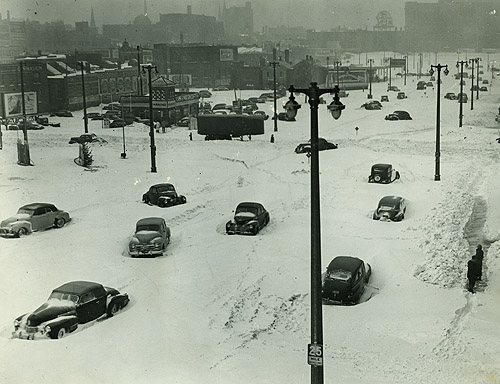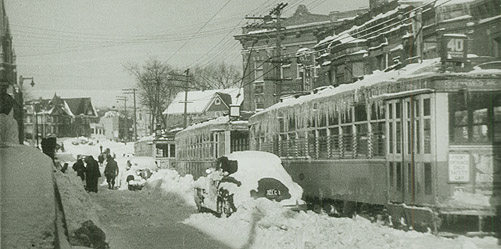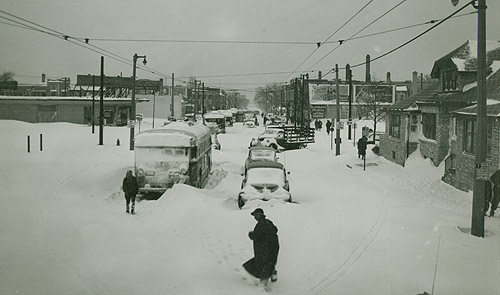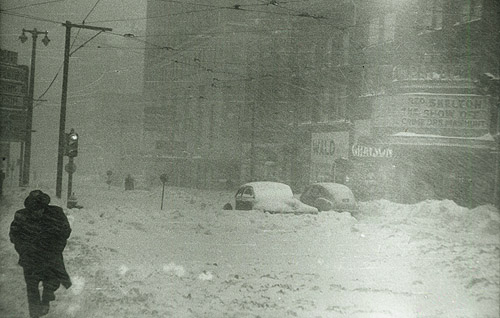1947, The Blizzard That Stopped Milwaukee Cold
It's a Wonderful Life was playing at the 3,000 seat Alhambra Theater in Downtown on January 28th, 1947. Paperboys delivered The Milwaukee Journal after school. The front page carried the U.S. Weather Bureau (renamed National Weather Service in 1970) forecast of "an inch or so of snow" for Wednesday, January 29th.
City of Milwaukee Department of Public Works (DPW) Bureau of Street Sanitation employees started work at 7:00 p.m. as a light snowfall began and prepared for late evening and overnight street sanding. The light snowfall ended about 2:45 a.m., which led sanitation supervisors to conclude that this was the forecasted inch of snow. They decided not to mount plows on garbage trucks and sent them on their morning ash (coal) and rubbish collection.
It started to snow about 8:30 a.m. as people went to work and children walked to school. By 10:00 a.m., it was obviously a blizzard with thunder snow and wind gusting up to 60 m.p.h. After street sanding and ash and garbage pickup for 17 hours, DPW workers were sent home at Noon to rest and told to return for 10:00 p.m. snow plowing. Most wouldn't be able to return to work that evening.
 |
| Cars stuck in the snow on W Kilbourn Avenue, from the Remember When... Collection. Published in LIFE on February 10, 1947 and The Milwaukee Journal, Green Sheet on February 5, 1966, |
Cars, trucks and buses became stuck during the afternoon rush hour. 20-25 ton streetcars were blocked by stuck motor vehicles. As night fell, streetcar and trolleybus (trackless trolleys in Milwaukee-ese) poles were kept up for light and heat and became makeshift hotels for stranded riders and rest stops for pedestrians and drivers trying to walk home. Hotels quickly filled up and latecomers slept in telephone booths in lobbies and train stations. The few DPW snowplows operating were used to clear paths for police cars and ambulances. 9.6 inches of snow was recorded at Mitchell Field.
At the January 29th, 1997 50th anniversary program at the UWM Extension in the Plankinton Arcade, a former Milwaukee Public Library employee in her 70s recalled she was one of 11 workers stranded overnight at the Central Library after closing at 9:30 p.m. and slept uncomfortably on tables.
An additional 6.8 inches of snow fell on Thursday, January 30th until it finally ended at 6:30 p.m. The Rapid Transit interurban (light rail) line between Downtown and Waukesha was the only public transit line running. The Central Library and Milwaukee Public Museum (then housed in the Central Library) reopened on Thursday, January 30th with their stranded staffs and were the only city public services operating besides DPW snowplow crews, and police and fire departments. The Museum had zero attendance. The Milwaukee Journal dispatched two skiers to deliver the newspaper to their WTMJ (The Milwaukee Journal Station) Radio City station on E. Capitol Dr. to be read on the radio.
 |
| Frozen streetcars at S Kinnickinnic and E Potter Avenues, from our Historic Photo Collection |
One of the most amazing stories involved Gladys Friedland, who was partially paralyzed by childhood polio. The Milwaukee Journal reported that she was stranded for 26 hours on an #18 National-Fond du Lac streetcar at W. National Ave. and S. 14th St. Teenagers Dick Thompson and Bernard Clary poked their heads into the car and she asked them "Would you boys get a sled or toboggan and pull me to my home at N. 3rd (Dr. Martin Luther King Dr.) and W. Clarke Sts.?"
The teens borrowed a toboggan from a friend and hauled her for five miles in deep snow for two-and-a-half hours. When they reached Friedland's home, they were fed, rested and paid $3 per person ($32 in 2016 dollars) before trudging home at 11:00 p.m.
Milwaukee started to slowly recover from the two-day 16.4 inch blizzard on Friday, January 31st. The City hired 3,400 shovelers, who reported to ward yards to pick up shovels to start shoveling out stuck cars blocking DPW and Transport Co. (MCTS) snowplows trying to plow main roads and streetcar tracks. Partial service on a handful of car lines resumed.
 |
| More stranded cars at W North Avenue and N 49th Street, from our Historic Photo Collection |
The Common Council met in an emergency session on Saturday, February 1st. They voted to buy more snowplows than were purchased during the previous 11 years combined (Great Depression and World War II). DPW only had one V plow and most of their obsolete 1920s plows were bought shortly after the February 4th-5th, 1924 blizzard (20.3 inches) shut Milwaukee down. Department stores reopened, but sales figures were down more than 70%.
Businesses and schools reopened, and full streetcar and trolleybus service resumed on Monday, February 3rd. Full orange and Green bus service resumed, and N. Sherman Blvd. and W. Burleigh St. reopened by Wednesday, February 5th, six days after the blizzard ended.
It would take another month to finish plowing side streets. Unfortunately, five deaths and an estimated $75 million ($807 million in 2016 dollars) in snow removal costs, lost wages and economic activity were attributed to the blizzard.
 |
| Wisconsin Avenue gets blanketed, from our Historic Photo Collection |
The 1947 Blizzard is the yardstick that all snowstorms since then are measured by. While the unexpected April 9th, 1973 storm shut down Milwaukee for two days with 13 inches of snow, the Groundhog Day blizzard (17.6 inches of thunder snow over two days) six years ago comes closest to mirroring 1947. The National Weather Service and local TV news meteorologists used the advantage of weather satellites and radars that didn't exist 70 years ago to forecast and warn Milwaukeeans days in advance to prepare for it.
For more information, read Don Neuman's When the Trolleys were Stopped Cold: the Great Snowstorm of '47 and watch Ch. 10's I Remember Milwaukee "Blizzard of 1947" episode.
The Central Library has a 1947 blizzard 70th anniversary display on the 2nd floor near the Frank Zeidler Humanities Room until February 11th. It includes The Milwaukee Journal and LIFE from the Periodicals collection, and photos from the Remember When... Collection. The Historic Photo Collection includes snapshots attributed to C.J. Baumann, whom might have been father and son dentists Charles J. Baumann Sr. and Jr. Photos by DPW bridgetender and prolific photographer August Riemenschneider are part of the display. One of his photos was used in a blog entry about an unusual experiment gone wrong at the old Washington Park Zoo.
When invited to speak at a library program about the blizzard that stopped Milwaukee cold five years ago, Neuman replied from the warmth of his Arizona home that he has "seen enough snow in January."
Dan, Local History Librarian
